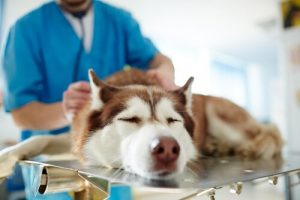6 Dog Diseases in Autumn

Even though many people love fall, there are many diseases your dog can catch at this time of the year. During autumn, the leaves change color and the cold winds that precede the winter start to blow. Finally, you have a moment to get away from the relentless heat of the summer.
Unfortunately, autumn also implies a series of risks for your dogs, and that cold makes dogs prone to diseases. Here are some of the most common conditions dogs can experience during this time:
Dog diseases in autumn
1. Lower defenses
Like all animals, dogs suffer from a sudden decline in defenses during the fall. Our immune system becomes weaker due to the sun emitting lower amounts of vitamin D. Dogs can get sick more easily than at other times of the year.
The low defenses caused by the change in temperatures can easily be compensated with a proper diet. A higher intake of nutrients can prevent your dog’s immune system from weakening.
2. Leishmaniasis
Due to dogs’ immune system weakening during in autumn, the risk of contamination by bacteria and viruses is greater.
Leishmaniasis is usually transmitted by mosquitos towards the end of summer. Once a dog is bitten, the disease will take a few weeks to appear. For this reason, the owners must keep a close watch for any symptoms: remember that this disease must be treated by a veterinarian.

3. Kennel cough
Kennel cough is the colloquial name for tracheobronchitis, which is one of the most common diseases for dogs during the autumn. The risk of infection is very high in places where there is a lot of contact between dogs: dog parks and dog kennels are very common sources of infection.
Kennel cough is an infectious disease similar to the flu, which causes coughing and sneezing, and can even cause fevers. Sometimes a kennel cough can be cured within days. However, it’s recommended that you take your dog to the veterinarian in order to receive proper medical attention.
4. Parasites
Parasites are quite common throughout the year, but the risk increases in fall. Fleas and ticks are spread from one dog to another in social settings because the weather is still not cold enough to eliminate them.
In addition to how difficult it can be to completely eliminate an infestation of fleas or ticks, they carry with many diseases that spread easily from one dog to another. Ask your veterinarian what is the best preventive measure for your dog.
5. Osteoarthritis
Unfortunately, osteoarthritis is one of the most common diseases that affects older dogs. It’s a painful condition that has no cure. The only thing an owner can do for their dog with osteoarthritis is to try to relieve symptoms.
When temperatures drop during the fall, dogs begin to feel more pain. To avoid the pain caused by osteoarthritis, try to keep your dog warm by using thick blankets and comfortable cushions. When going out for a walk it’s necessary to put a coat on your dog and have them wear a rain jacket when it’s raining.

6. Shedding
Although it’s not a disease, shedding can also affect your dog’s health.
Dogs lose fur throughout the year. However, this usually takes when the seasons change, especially from summer to autumn. In the summer, your dog’s hair becomes thin and light. The heat makes the animals that are covered with hairs try to be a little cooler.
When autumn arrives, their summer coat becomes useless. The cold winds cause the dog’s hair to become thicker. During this shedding period, it’s necessary for owners to brush their dog’s fur. In this way, the dead fur will be removed and the coat can grow healthier.
If the old hair isn’t removed, your dog could develop skin diseases due to an excessive amount of mites, which are the causes of very uncomfortable blisters and allergies.
The most important thing during the fall is to keep your dog warm and avoid sudden changes in temperature. Also, try to provide them with a diet that’s high in vitamin B, C, and D. By doing so, you’ll reduce the deficiencies that their immune system may have.
Don’t be scared if your dog gets sick during the fall, because it’s quite common. Of course, if your dog begins to show symptoms of diseases, take them to the vet immediately.
Even though many people love fall, there are many diseases your dog can catch at this time of the year. During autumn, the leaves change color and the cold winds that precede the winter start to blow. Finally, you have a moment to get away from the relentless heat of the summer.
Unfortunately, autumn also implies a series of risks for your dogs, and that cold makes dogs prone to diseases. Here are some of the most common conditions dogs can experience during this time:
Dog diseases in autumn
1. Lower defenses
Like all animals, dogs suffer from a sudden decline in defenses during the fall. Our immune system becomes weaker due to the sun emitting lower amounts of vitamin D. Dogs can get sick more easily than at other times of the year.
The low defenses caused by the change in temperatures can easily be compensated with a proper diet. A higher intake of nutrients can prevent your dog’s immune system from weakening.
2. Leishmaniasis
Due to dogs’ immune system weakening during in autumn, the risk of contamination by bacteria and viruses is greater.
Leishmaniasis is usually transmitted by mosquitos towards the end of summer. Once a dog is bitten, the disease will take a few weeks to appear. For this reason, the owners must keep a close watch for any symptoms: remember that this disease must be treated by a veterinarian.

3. Kennel cough
Kennel cough is the colloquial name for tracheobronchitis, which is one of the most common diseases for dogs during the autumn. The risk of infection is very high in places where there is a lot of contact between dogs: dog parks and dog kennels are very common sources of infection.
Kennel cough is an infectious disease similar to the flu, which causes coughing and sneezing, and can even cause fevers. Sometimes a kennel cough can be cured within days. However, it’s recommended that you take your dog to the veterinarian in order to receive proper medical attention.
4. Parasites
Parasites are quite common throughout the year, but the risk increases in fall. Fleas and ticks are spread from one dog to another in social settings because the weather is still not cold enough to eliminate them.
In addition to how difficult it can be to completely eliminate an infestation of fleas or ticks, they carry with many diseases that spread easily from one dog to another. Ask your veterinarian what is the best preventive measure for your dog.
5. Osteoarthritis
Unfortunately, osteoarthritis is one of the most common diseases that affects older dogs. It’s a painful condition that has no cure. The only thing an owner can do for their dog with osteoarthritis is to try to relieve symptoms.
When temperatures drop during the fall, dogs begin to feel more pain. To avoid the pain caused by osteoarthritis, try to keep your dog warm by using thick blankets and comfortable cushions. When going out for a walk it’s necessary to put a coat on your dog and have them wear a rain jacket when it’s raining.

6. Shedding
Although it’s not a disease, shedding can also affect your dog’s health.
Dogs lose fur throughout the year. However, this usually takes when the seasons change, especially from summer to autumn. In the summer, your dog’s hair becomes thin and light. The heat makes the animals that are covered with hairs try to be a little cooler.
When autumn arrives, their summer coat becomes useless. The cold winds cause the dog’s hair to become thicker. During this shedding period, it’s necessary for owners to brush their dog’s fur. In this way, the dead fur will be removed and the coat can grow healthier.
If the old hair isn’t removed, your dog could develop skin diseases due to an excessive amount of mites, which are the causes of very uncomfortable blisters and allergies.
The most important thing during the fall is to keep your dog warm and avoid sudden changes in temperature. Also, try to provide them with a diet that’s high in vitamin B, C, and D. By doing so, you’ll reduce the deficiencies that their immune system may have.
Don’t be scared if your dog gets sick during the fall, because it’s quite common. Of course, if your dog begins to show symptoms of diseases, take them to the vet immediately.
This text is provided for informational purposes only and does not replace consultation with a professional. If in doubt, consult your specialist.








